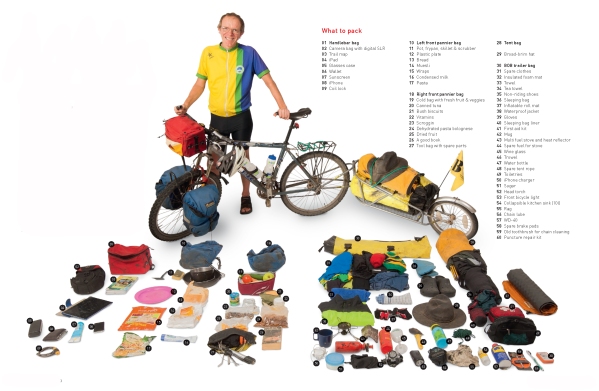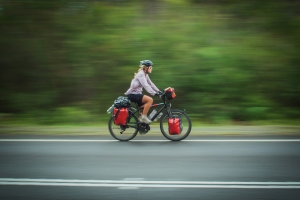Jon Miller covers the basics of bike touring.

Away from the hustle and bustle of cities, bike touring is a unique style of getaway – an adventure on wheels to interesting places, and can be as easy or as challenging as you choose. Touring can take you through a huge variety of landscapes and experiences, from tough mountain climbs and exhilarating descents to slow and relaxing trips with more time spent visiting gourmet wine and food outlets than actually riding.
Australia’s diverse terrain offers ever-changing scenery as you cycle at your own pace and connect with the sights, sounds and smells of the countryside. It’s all about the journey between destinations – about stopping to enjoy and explore things you might otherwise miss.
Anybody can go touring, including young children, on any sort of bike. It’s possible to spend thousands of dollars on a dedicated touring bike or to custom build your own. But don’t let this put you off; you can tour on the bike you own now. It’s preferable to have some luggage carrying capacity, though it’s not essential. A light back pack is often all you need for a short credit-card tour in fine weather. However, back packs aren’t recommended for heavier loads as they can upset your balance on the bike and tire you out prematurely; it’s better to have racks and panniers and let the bike carry the load.
Types of touring
Bike touring is generally thought of as riding for two or more days and staying somewhere other than your home town, but there are many different ways to do this.
Credit card touring
Riders carry very little, just some basic tools, a change of clothes and a few snacks. The trip is planned around staying in accommodation (such as B&Bs, pubs, motels, hostels or caravan park cabins) and buying all meals along the way. It’s the easiest way to tour by bike, but also the most expensive.
 Self-sufficient touring
Self-sufficient touring
People often marvel at the weight of the loaded panniers self-supported bike tourists use to carry their gear. All four panniers on a touring bike are loaded up front and rear with clothes, camping and cooking gear, food, water and tools. Riders might camp along the roadside, or in a national park or caravan park. They’re happy to ride all day, stop where they want, cook food carried in their panniers and sleep in an outdoor setting. Self-supported tourists usually ride a touring bicycle with a wide range of gears, stronger wheels to carry the load and a longer wheel base for stability and to accommodate panniers. The big advantage of this type of touring is that you can go anywhere you like.
These are two extremes. Many people opt for something between the two. They might camp in towns and eat out at a pub, or carry most of their food but cook it in the camp kitchen of a caravan park or a self-contained unit, or camp some of the time but stay in accommodation when the weather is bad or they feel like a break.
Base camp touring
This involves transporting your bike and gear to the start of a ride and setting up there. Each day you go for a ride and return to the same place every night. Base camps allow you to really get to know and explore an area. You can normally ride further because you don’t need to carry much with you each day. They’re particularly good for groups of riders with differing abilities. You can go on separate rides during the day and meet up in the evenings to swap stories.
Supported touring
This can range from one person in a car carrying the bags of a group of friends, to mass participation events such as the RACV Great Victorian Bike Ride and Cycle Queensland. A mass-participation ride is a great way to tour and meet people. These rides last for several days and can have thousands of riders. If the crowds put you off, many commercial operators run tours for smaller groups. Meals are provided, luggage is carried and there is a ‘sag wagon’ to give you a lift if you get too tired. Accommodation typically involves camping overnight and daily distances are usually about 80 km.
Self-guided touring
These tours are popular in Europe and there are a handful of operators in Australia now. The tour operator supplies maps, riding directions and sometimes even a GPS with the route pre-loaded. They will meet you every morning to pick up your luggage and drive it to your destination that night. They will normally book the accommodation for you and sometimes supply dinner and breakfast. You are responsible for finding your way each day but you can also spend as long as you like taking in the sights along the way. Self-guided tours are often a very cost-effective way for couples and small groups to explore an unfamiliar region.
 How to pack the bike
How to pack the bike
While it’s possible to go touring and carry your luggage in a back pack, it’s preferable to have luggage racks permanently bolted to the bike’s frame and panniers which clip on to the racks. Many people assume that you must evenly distribute the load on each side of the bike, but this is untrue. Just as you can carry a heavy weight in one arm without toppling over, you can ride a bike with only one pannier and not even notice the difference. Having evenly weighted front panniers makes steering easier but you don’t need to spend a lot of time worrying about it. Near enough is normally good enough.
It is far more important to get the weight distribution right between the front and back of the bike. A person riding with no luggage will have about sixty per cent of their weight over the back wheel. When packing panniers, try to keep the same 60/40 weight distribution. Carrying too much weight on the rear is quite dangerous as it upsets the handling of the bike. The front end becomes too light relative to the back which can cause it to bounce around, particularly over rough roads. Steering is also more difficult with all the weight on the back.
I often tow a small trailer when touring because it’s easier to unpack and repack it every day than having everything distributed in four panniers. I still use front panniers or a large handlebar bag to keep the front of the bike down and to make it more stable. Accessing gear carried in my trailer is a bit of a hassle so I keep things in the front panniers that I may need during the day.
Think about what you will need when you are riding and what you won’t need until you stop for the night, and pack accordingly. I normally carry a handlebar bag with camera, maps, iPad and snacks – things I will access regularly throughout the day. Front panniers are for items I may want to get to at some stage: raincoat, first-aid kit, spare tube, etc. Lunch goes in the front too for easy access, as does most of the rest of my food, to keep it all in one place. Camping gear, clothes, stove and other miscellaneous items go in the trailer or rear panniers.
Keeping your gear dry is important too. Even if your panniers are labelled as 100% waterproof, overfilling them or incorrectly doing them up means rain water can and will get in. At the very least, ensure your most important things such as warm clothing and sleeping bag are in plastic bags inside your panniers. Many people will strap large items, such as a tent or folding chair, to the top of the rear rack. This is a good way to save space in the panniers, but make sure they are securely fastened. You don’t want to arrive at your destination to realise that you have inadvertently left your tent behind.
Keeping your devices charged
Very few of us go anywhere without a mobile phone these days. I normally carry an iPad and there are many people who take laptops and GPS devices too. Keeping all of these electronic toys charged can be difficult. When I bought my first digital camera, I went on extended tours carrying dozens of disposable batteries; fortunately, things are easier these days.
There are several devices available which regulate the power supplied by a hub dynamo and allow anything to be charged via a USB connector. Small solar panels can also be used.
There are simpler options though, such as asking the café owner if you can plug in your phone while you have your coffee, charging your laptop while you’re in the pub having dinner or cooking at the camp kitchen; or buying lithium batteries for your GPS which last significantly longer than alkalines.
Touring tips
• If you have a mechanical problem, don’t be afraid to ask a farmer or service station proprietor for assistance. These people are often very resourceful and happy to help out.
• Carry some basic tools including a chain breaker. Even if you don’t know how to use them, chances are that someone you meet will.
• Don’t skimp on what you eat – it’s your fuel. The bike rider’s ‘bonk’ can stop you dead. You can easily eat twice as much touring as you do at home.
• Top up your water bottles at every opportunity.
• Put your sleeping bag inside a plastic bag and then inside the sleeping bag cover. The plastic will keep it dry and the cover will protect the plastic from tears.
For day-rides rides closer to home have a look at our guide to day-tripping by bike. For more about self-sufficient cycle touring, Nicola Dunnicliff-Wells has a wealth of experience to share.
Ride On content is editorially independent, but is supported financially by members of Bicycle Network. If you enjoy our articles and want to support the future publication of high-quality content, please consider helping out by becoming a member.

Great article. Those seeking the self guided touring option could check out Tour de Vines which is offering new self guided tours in various places in Australia. http://Www.tourdevines.com.au
Love the bit about packing your panniers – we spent most of our trip packing/repacking….
And lots of water is a must also electrolytes – in Thailand we easily churned through 6 litres of water each a day
Other great sites for research are http://www.travellingtwo.com – they have a couple of books about the subject. The best touring blog is http://www.goingslowly.com – Tara & Tyler inspired us to cycle across Europe & SE Asia with no training what so ever
Great ideas Jon, would love to talk to you further – contact us through our cycling holiday website: http://www.outdoortravel.com.au Martyn
I’ve gone on bike tours that go for three to four weeks each year for a couple of years now. It’s way more fun than I ever imagined it would be! I’m just about to head off and cross Italy, north to south into Sicily.
From my experience, the best advice is to pack lightly, you’ll have to carry everything you pack with you. If you’re in doubt about something it’s probably wiser to leave it at home. Unless you’re heading to remote countryside you’ll likely to be able to buy things along the way if you find you really need it. Another thing I learnt is to pack valuables (passport, phone, etc.) into zip-lock bags. You’d be surprised how even your waterproof paniers can get wet after spending a full day in heavy rain.
Finally, before you go on a long trip, test the waters on a small two or three day trip over a weekend.